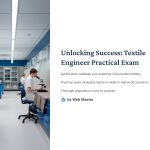 Achieving certification as a Textile Engineer is a pivotal step for professionals aiming to solidify their expertise in the textile industry. The practical exam, in particular, assesses one’s ability to apply theoretical knowledge to real-world scenarios, making thorough preparation essential. This article delves into effective strategies and personal experiences to guide you toward success in the Textile Engineer practical examination.
Achieving certification as a Textile Engineer is a pivotal step for professionals aiming to solidify their expertise in the textile industry. The practical exam, in particular, assesses one’s ability to apply theoretical knowledge to real-world scenarios, making thorough preparation essential. This article delves into effective strategies and personal experiences to guide you toward success in the Textile Engineer practical examination.

Understanding the Significance of the Practical Exam
The practical component of the Textile Engineer certification evaluates candidates on their hands-on skills and problem-solving abilities within textile processes. It encompasses tasks such as operating textile machinery, conducting quality assessments, and implementing manufacturing protocols. Excelling in this exam not only demonstrates technical proficiency but also enhances career prospects by showcasing one’s capability to handle industry-specific challenges.

Developing a Comprehensive Study Plan
A structured study plan is crucial for effective preparation. Begin by identifying the core competencies required for the exam, such as textile material properties, processing techniques, and quality control measures. Allocate dedicated time slots for each topic, ensuring a balanced approach that covers both theoretical concepts and practical applications. Incorporate regular assessments to monitor progress and adjust the study plan accordingly.

Gaining Hands-On Experience
Practical experience is invaluable when preparing for the exam. Engage in internships or workshops that offer exposure to textile manufacturing environments. Hands-on practice with machinery and quality testing instruments enhances understanding and builds confidence. For instance, familiarity with equipment like tensile strength testers and dyeing machines can be pivotal during the examination.

Utilizing Diverse Learning Resources
Leverage a variety of learning materials to enrich your preparation:
- Textbooks and Manuals: Comprehensive guides on textile engineering principles provide foundational knowledge.
- Online Tutorials and Webinars: Digital platforms offer tutorials on specific techniques and emerging industry trends.
- Study Groups: Collaborating with peers facilitates knowledge exchange and offers diverse problem-solving perspectives.

Simulating Exam Conditions
Recreating exam scenarios through mock tests is an effective strategy. Simulations help in understanding time constraints and identifying areas that require improvement. Focus on tasks such as fabric analysis, process optimization, and troubleshooting common issues in textile production.

Staying Updated with Industry Trends
The textile industry is continually evolving with advancements in technology and sustainable practices. Staying informed about the latest developments can provide an edge in the exam. Topics like smart textiles, eco-friendly materials, and innovative manufacturing processes are increasingly relevant and may be reflected in the examination content.
Official Guidelines and Resources
Access Official Exam Guidelines
Explore Textile Engineering Resources
Conclusion
Success in the Textile Engineer practical exam is attainable through meticulous preparation, practical experience, and continuous learning. By embracing a comprehensive study approach and staying abreast of industry innovations, candidates can confidently navigate the examination and advance their careers in textile engineering.
*Capturing unauthorized images is prohibited*






